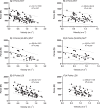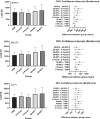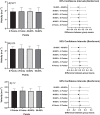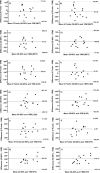Force-velocity relationship in Paralympic powerlifting: two or multiple-point methods to determine a maximum repetition
- PMID: 36002849
- PMCID: PMC9400284
- DOI: 10.1186/s13102-022-00552-9
Force-velocity relationship in Paralympic powerlifting: two or multiple-point methods to determine a maximum repetition
Abstract
Background: Due to the absence of evidence in the literature on Paralympic Powerlifting the present study investigated various methods to assess bench press maximum repetition and the way each method influences the measurement of minimum velocity limit (MVT), load at zero velocity (LD0), and force-velocity (FV).
Objective: To evaluate the precision of the multi-point method using proximal loads (40, 50, 60, 70, 80, and 90% of one repetition maximum; 1RM) compared to the four-point method (50, 60, 70, and 80% of 1RM) and the two-point method using distant loads (40 and 80% and 50 and 80% of 1RM) in in the MVT, LD0, and FV, in bench press performed by Paralympic Powerlifters (PP).
Methods: To accomplish this, 15 male elite PP athletes participated in the study (age: 27.7 ± 5.7 years; BM: 74.0 ± 19.5 kg). All participants performed an adapted bench press test (free weight) with 6 loads (40, 50, 60, 70, 80, and 90% 1RM), 4 loads (50, 60, 70, and 80% 1RM), and 2 loads (40-80% and 50-80% 1RM). The 1RM predictions were made by MVT, LD0, and FV.
Results: The main results indicated that the multiple (4 and 6) pointsmethod provides good results in the MVT (R2 = 0.482), the LD0 (R2 = 0.614), and the FV (R2 = 0.508). The two-point method (50-80%) showed a higher mean in MVT [1268.2 ± 502.0 N; ICC95% 0.76 (0.31-0.92)], in LD0 [1504.1 ± 597.3 N; 0.63 (0.17-0.86)], and in FV [1479.2 ± 636.0 N; 0.60 (0.10-0.86)].
Conclusion: The multiple-point method (4 and 6 points) and the two-point method (40-80%) using the MVT, LD0, and FV all showed a good ability to predict bench press 1RM in PP.
Keywords: Force–velocity relationship; Load estimation; Multiple-load method; Paralympics; Powerlifting.
© 2022. The Author(s).
Conflict of interest statement
The authors declare that they have no competing interests.
Figures






Similar articles
-
A Bibliometrics-Enhanced, PAGER-Compliant Scoping Review of the Literature on Paralympic Powerlifting: Insights for Practices and Future Research.Healthcare (Basel). 2022 Nov 19;10(11):2319. doi: 10.3390/healthcare10112319. Healthcare (Basel). 2022. PMID: 36421643 Free PMC article.
-
Load-Velocity Relationship in National Paralympic Powerlifters: A Case Study.Int J Sports Physiol Perform. 2019 Apr 1;14(4):531-535. doi: 10.1123/ijspp.2018-0452. Epub 2019 Feb 19. Int J Sports Physiol Perform. 2019. PMID: 30204509
-
Group versus Individualised Minimum Velocity Thresholds in the Prediction of Maximal Strength in Trained Female Athletes.Int J Environ Res Public Health. 2020 Oct 26;17(21):7811. doi: 10.3390/ijerph17217811. Int J Environ Res Public Health. 2020. PMID: 33114479 Free PMC article.
-
Use of Machine-Learning and Load-Velocity Profiling to Estimate 1-Repetition Maximums for Two Variations of the Bench-Press Exercise.Sports (Basel). 2021 Mar 16;9(3):39. doi: 10.3390/sports9030039. Sports (Basel). 2021. PMID: 33809614 Free PMC article.
-
An Efficient and Accurate Approach for Estimating the Free-Weight Back Squat 1-Repetition Maximum Based on the 2-Point Method and Optimal Minimal Velocity Threshold.J Strength Cond Res. 2025 Apr 1;39(4):e530-e537. doi: 10.1519/JSC.0000000000005040. Epub 2024 Dec 19. J Strength Cond Res. 2025. PMID: 39705159
Cited by
-
A Bibliometrics-Enhanced, PAGER-Compliant Scoping Review of the Literature on Paralympic Powerlifting: Insights for Practices and Future Research.Healthcare (Basel). 2022 Nov 19;10(11):2319. doi: 10.3390/healthcare10112319. Healthcare (Basel). 2022. PMID: 36421643 Free PMC article.
-
A Scoping Review with Bibliometric Analysis of Para-Rowing: State of the Art and Future Directions.Healthcare (Basel). 2023 Mar 13;11(6):849. doi: 10.3390/healthcare11060849. Healthcare (Basel). 2023. PMID: 36981506 Free PMC article.
-
Enhancing Post-Training Muscle Recovery and Strength in Paralympic Powerlifting Athletes with Cold-Water Immersion, a Cross-Sectional Study.Int J Environ Res Public Health. 2025 Jan 18;22(1):122. doi: 10.3390/ijerph22010122. Int J Environ Res Public Health. 2025. PMID: 39857575 Free PMC article.
-
Optimization of applied loads for assessing load-velocity relationship during back squat.PLoS One. 2025 Jul 18;20(7):e0328772. doi: 10.1371/journal.pone.0328772. eCollection 2025. PLoS One. 2025. PMID: 40680015 Free PMC article.
-
Is two-point method a valid and reliable method to predict 1RM? A systematic review.PLoS One. 2023 Nov 20;18(11):e0294509. doi: 10.1371/journal.pone.0294509. eCollection 2023. PLoS One. 2023. PMID: 37983216 Free PMC article.
References
-
- Aidar FJ, de Oliveira RJ, de Matos DG, Mazini Filho ML, Moreira OC, de Oliveira CE, Hickner RC, Reis VM. A Randomized trial investigating the influence of strength training on quality of life in ischemic stroke. Top Stroke Rehabil. 2016;23(2):84–89. doi: 10.1080/10749357.2015.1110307. - DOI - PubMed
-
- Mazini Filho ML, Aidar FJ, Gama de Matos D, Costa Moreira O, de Oliveira CEP, de Oliveira R, Venturini G, Magalhães Curty V, Menezes Touguinha H, Caputo Ferreira ME. Circuit strength training improves muscle strength, functional performance and anthropometric indicators in sedentary elderly women. J Sports Med Phys Fitness. 2018;58(7–8):1029–1036. - PubMed
-
- Mazini Filho ML, Aidar FJ, Moreira OC, Matos DG, Oliveira CEP, Venturini GRO, Costa SP, Curty VM, Ferreira MEC. Comparison of the effect of two physical exercise programs on the functional autonomy, balance and flexibility of elderly women. Med Sport. 2017;70:288–298. doi: 10.23736/S0025-7826.17.03012-5. - DOI
LinkOut - more resources
Full Text Sources
Miscellaneous

